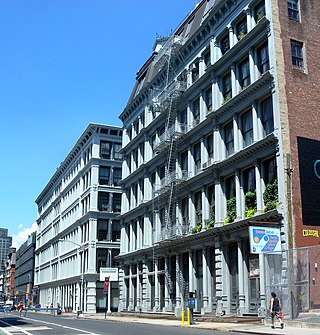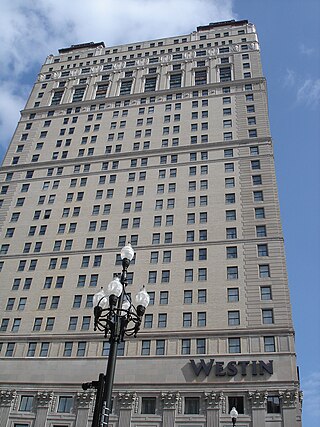
SoHo, is a neighborhood in Lower Manhattan, New York City. Since the 1970s, the neighborhood has been the location of many artists' lofts and art galleries, and has also been known for its variety of shops ranging from trendy upscale boutiques to national and international chain store locations. The area's history is an archetypal example of inner-city regeneration and gentrification, encompassing socioeconomic, cultural, political, and architectural developments.

Nolita, sometimes written as NoLIta and deriving from "North of Little Italy", is a neighborhood in the borough of Manhattan in New York City. Nolita is situated in Lower Manhattan, bounded on the north by Houston Street, on the east by the Bowery, on the south roughly by Broome Street, and on the west by Lafayette Street. It lies east of SoHo, south of NoHo, west of the Lower East Side, and north of Little Italy and Chinatown.

NoHo, short for "North of Houston Street", is a primarily residential neighborhood in Lower Manhattan, New York City. It is bounded by Mercer Street to the west, the Bowery to the east, 9th Street to the north, and Houston Street to the south.

A penthouse is an apartment or unit traditionally on the highest floor of an apartment building, condominium, hotel, or tower. Penthouses are typically differentiated from other apartments by luxury features. The term 'penthouse' originally referred, and sometimes still does refer, to a separate smaller 'house' that was constructed on the roof of an apartment building. Architecturally it refers specifically to a structure on the roof of a building that is set back from its outer walls. These structures do not have to occupy the entire roof deck. Recently, luxury high rise apartment buildings have begun to designate multiple units on the entire top residential floor or multiple higher residential floors including the top floor as penthouse apartments, and outfit them to include ultra-luxury fixtures, finishes, and designs which are different from all other residential floors of the building. These penthouse apartments are not typically set back from the building's outer walls, but are instead flush with the rest of the building and simply differ in size, luxury, and consequently price. High-rise buildings can also have structures known as mechanical penthouses that enclose machinery or equipment such as the drum mechanisms for an elevator.

Theresa Hak Kyung Cha was an American novelist, producer, director, and artist of South Korean origin, best known for her 1982 novel, Dictée. Considered an avant-garde artist, Cha was fluent in Korean, English, and French. The main body of Cha's work is "looking for the roots of language before it is born on the tip of the tongue." Cha's practice experiments with language through repetition, manipulation, reduction, and isolation, exploring the ways in which language marks one's identity, in unstable and multiple expressions. Cha's interdisciplinary background was clearly evident in Dictée, which experiments with juxtaposition and hypertext of both print and visual media. Cha's Dictée is frequently taught in contemporary literature classes including women's literature.

The Westin Book Cadillac Detroit is an historic skyscraper hotel in downtown Detroit, Michigan, within the Washington Boulevard Historic District. Designed in the Neo-Renaissance style, and opened as the Book-Cadillac Hotel in 1924, the 349 ft (106 m), 31-story, 453-room hotel includes 65 exclusive luxury condominiums and penthouses on the top eight floors. It reopened in October 2008, managed by Westin Hotels, after a $200-million restoration.

660 Fifth Avenue is a 41-story office building on the west side of Fifth Avenue between 52nd and 53rd Streets in the Midtown Manhattan neighborhood of New York City. The office tower was designed by Carson & Lundin and built for its developer Tishman Realty and Construction from 1955 to 1957.
Kushner Companies LLC is an American real estate developer in the New York City metropolitan area. The company's biggest presence is in the New Jersey residential market.

Lafayette Street is a major north–south street in New York City's Lower Manhattan. It originates at the intersection of Reade Street and Centre Street, one block north of Chambers Street. The one-way street then successively runs through Chinatown, Little Italy, NoLIta, and NoHo and finally, between East 9th and East 10th streets, merges with Fourth Avenue. A buffered bike lane runs outside the left traffic lane. North of Spring Street, Lafayette Street is northbound (uptown)-only; south of Spring Street, Lafayette is southbound (downtown)-only.

Trump Park Avenue is a residential building on the southern border of Lenox Hill at 502 Park Avenue in Manhattan, New York City. The 32-story building, designed by Goldner and Goldner in 1929, today contains 120 luxury condominium apartments and 8 penthouses converted by real estate developer Donald Trump.

229 West 43rd Street is an 18-story office building in the Theater District of Midtown Manhattan in New York City. Opened in 1913 and expanded in three stages, it was the headquarters of The New York Times newspaper until 2007. The original building by Mortimer J. Fox of Buchman & Fox, as well as a 1920s addition by Ludlow & Peabody and a 1930s addition by Albert Kahn, are on 43rd Street. Shreve, Lamb & Harmon designed a wing on 44th Street in the 1940s. Columbia Property Trust owns most of the structure as an office building while Kushner Companies owns the lowest four floors as a retail and entertainment complex.

The American Bank Note Company Building is a five-story building at 70 Broad Street in the Financial District of Manhattan in New York City. The building was designed by architects Kirby, Petit & Green in the neo-classical style, and contains almost 20,000 square feet (1,900 m2) of space, with offices and residences on the upper floors. The exterior consists of a main facade on Broad Street with two columns, as well as side facades with pilasters on Beaver and Marketfield Streets.

108 Leonard is a residential structure in the Tribeca neighborhood of Manhattan in New York City, New York, United States. Built from 1894 to 1898, the building was constructed for the New York Life Insurance Company. Stephen Decatur Hatch created the original plans while McKim, Mead & White oversaw the building's completion. The building occupies a city block bounded by Broadway to the west, Leonard Street to the north, Lafayette Street to the east, and Catherine Lane to the south. It is a New York City designated landmark and is listed on the National Register of Historic Places.

810 Fifth Avenue is a luxury residential housing cooperative on the Upper East Side of Manhattan, New York City.

The New Era Building is an 1893 Art Nouveau commercial loft building at 495 Broadway, between Spring Street and Broome Street, in the SoHo section of Manhattan in New York City.

75 Rockefeller Plaza is a skyscraper on the north side of 51st Street in New York City, originally built as a northern extension of Rockefeller Center.

23 Beekman Place, also the Paul Rudolph Apartment & Penthouse, is an apartment building between 50th and 51st streets in the Turtle Bay neighborhood of Manhattan in New York City. Built c. 1869 as a five-story brownstone residence, it was substantially redesigned in the late 20th century by Paul Rudolph, an American architect and one-time dean of Yale University. It is one of the few known projects Rudolph designed in the city.

770 Broadway is a 1,200,000-square-foot (110,000 m2) landmarked mixed-use commercial office building in NoHo, Manhattan, in Lower Manhattan, New York City, occupying an entire square block between 9th Street on the north, Fourth Avenue to the east, 8th Street to the south, and Broadway to the west. The building is owned and managed by Vornado Realty Trust. It was completed in 1907 and renovated in 2000 per a design by Hugh Hardy.

The American Bank Note Company Printing Plant is a repurposed printing plant in the Hunts Point neighborhood of the Bronx in New York City. The main structure includes three interconnected buildings. The Lafayette wing, spanning the south side of the block, is the longest and tallest, incorporating an entrance at the base of a nine-story tower. The lower, more massive Garrison wing is perpendicular. These two were built first, and constitute the bulk of the complex. Prior to the American Bank Note Company purchasing the property, the land on which the printing plant was built had been part of Edward G. Faile's estate.

The Stavros Niarchos Foundation Library (SNFL), popularly known as the Mid-Manhattan Library, is a branch of the New York Public Library (NYPL) at the southeast corner of 40th Street and Fifth Avenue in the Midtown Manhattan neighborhood of New York City. It is diagonally across from the NYPL's Main Branch and Bryant Park to the northwest. The Stavros Niarchos Foundation Library has space for 400,000 volumes across a basement and seven above-ground stories. Its design includes 11,000 square feet (1,000 m2) of event space and 1,500 seats for library users.


























